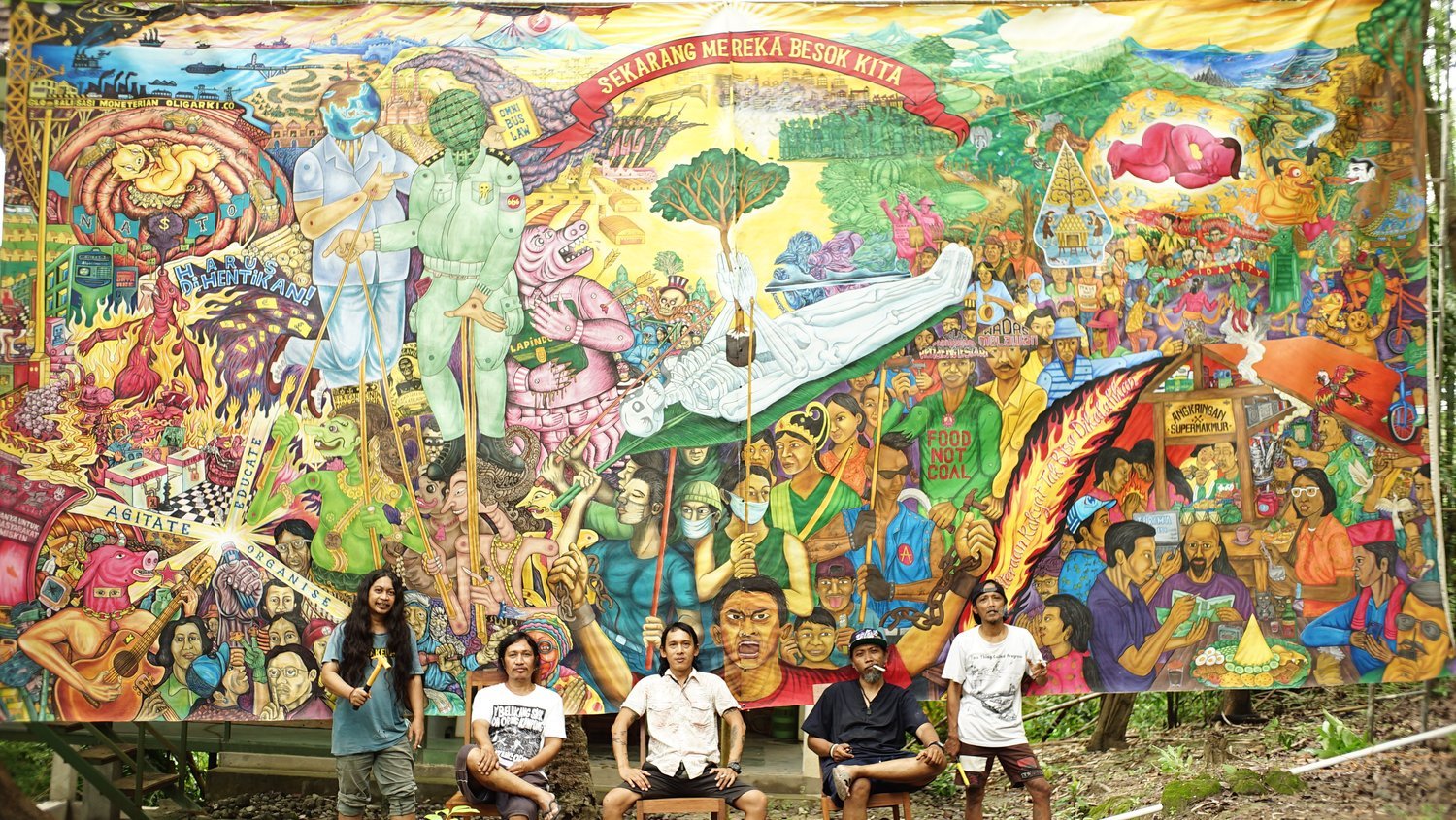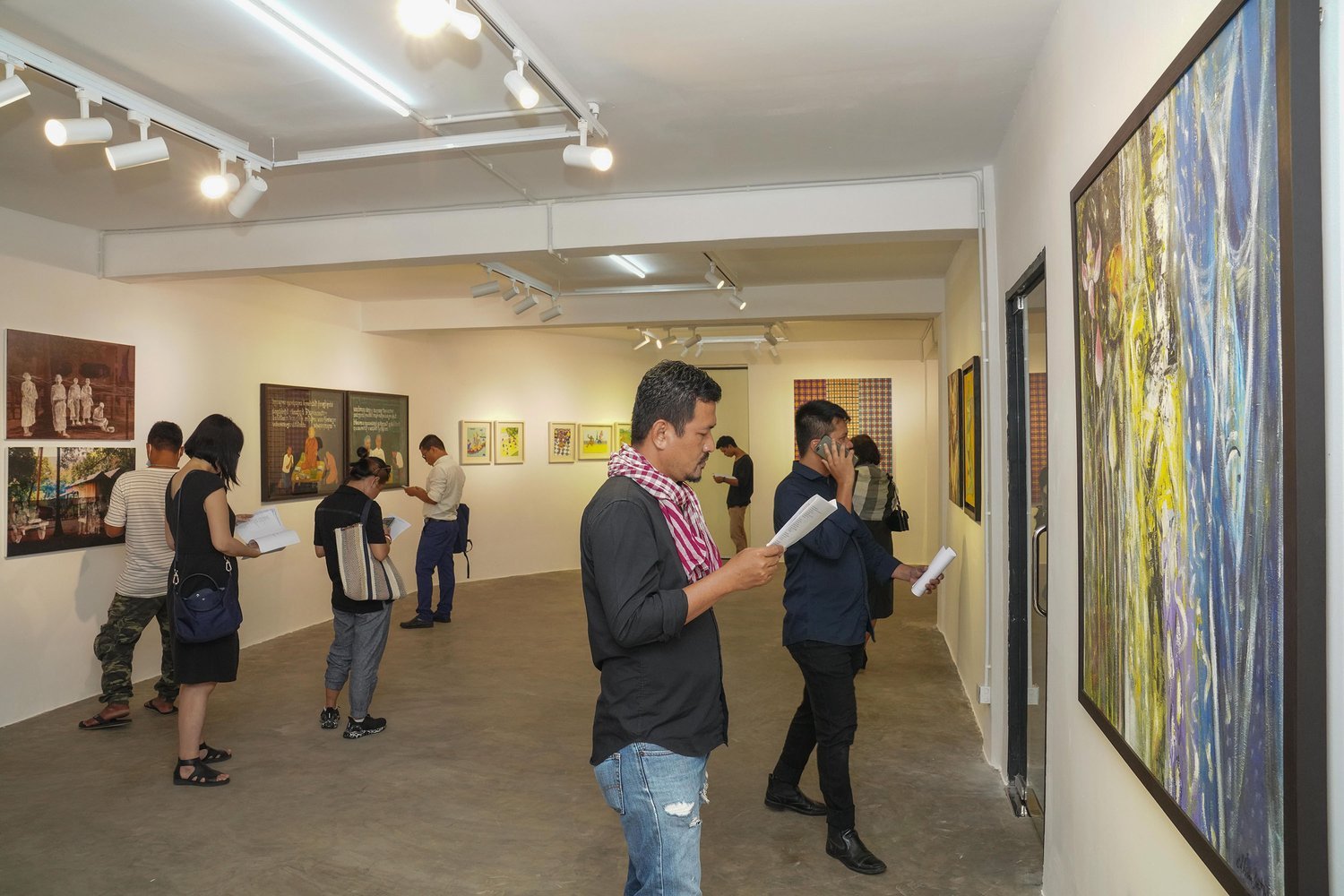Conversation with Taring Padi
Indonesian art collective at ‘documenta fifteen’
By Siti Nurlisa
Taring Padi, ‘Sekarang Mereka, Besok Kita’, 2021, acrylic on canvas, 400 x 115cm. Image courtesy of Taring Padi.
Taring Padi is an art collective based in Yogyakarta, Indonesia, formed in 1998 after the fall of President Suharto’s New Order regime. They are known for rejecting the notion of art for art's sake, and use their work to convey socio-political messages. Their name refers to the sharp tip of the rice plant, which, upon contact with the skin, can cause it to itch. The collective believes in the use of their works to create an “itchy” effect on those in power. Taring Padi’s mission is to use art as a medium to advocate for and strategise a united front supporting democratic and popular change in Indonesia.
Taring Padi, ‘Seni Membongkar Tirani, 2011, acrylic on canvas, 450 x 300cm. Image courtesy of Taring Padi.
What can your audience expect from Taring Padi at ‘documenta fifteen’?
Taring Padi has a long history of working with community groups on social justice and environmental issues. Our creative ethos involves a collective process-focused production of artwork. We are well known for producing woodcut posters as well as creating ‘wayang kardus’ or cardboard puppets, murals, banners, sculptures, and street theatre performances to support social and political actions. Audiences can expect these presentations in Kassel:
In the indoor display in the Hallenbad, we will present curated artefacts that have been used in our past events from Taring Pading’s 22-year history.
Outdoors, we will display five to 10 large-scale banners around Kassel. We will install hundreds of life-sized cardboard puppets in the city centre, we have made almost 700 pieces at the time of this interview. The cardboard puppets are produced through sharing skills in collaborative workshops with activist community groups in Indonesia and abroad, and give voice to the diverse range of social justice and environmental issues of importance to workshop participants.
We will organise workshops as knowledge exchange and networking events during ‘documenta fifteen’. This include the creation of mural in the historical site in the city
We will also organise direct action on site in the form of carnival by using the cardboard puppet and musical performances.
Production of ‘wayang kardus’ at Taring Padi’s Studio. Image courtesy of Taring Padi.
Drying the ‘wayang kardus’. Image courtesy of Taring Padi.
Who are the key members of the collective and what are their roles?
We are afraid this is a wrong question to ask in our case because when we work as a collective, individual identity becomes irrelevant. We prefer to be acknowledged as Taring Padi. There is a historical explanation to this. Taring Padi was founded at the height of the police state’s control of Indonesia, so that concealing identities of Taring Padi’s members was a necessity for security reasons. Organically, this practice continued after the fall of Suharto’s military dictatorship.
We believe this practice contributes to our continued existence as an art collective when there are no prominent individuals associated with Taring Padi. Having said that, we are not an underground or secret society. On the contrary, we are very open and inclusive. “Members” of Taring Padi often acknowledge their association with the collective in their individual capacities as an artist, academic or activist. We are perfectly happy with that.
Soft opening of Silapak Trotchaek Pneik art gallery. Photo by Bun Chan. Image courtesy of Silapak Trotchaek Pneik.
I know that is partly where you are trying to focus your efforts with your own gallery….
Yes. My hope is to do two things at the same time. The first is for the gallery to have an educational arm. This aims to include everyone in a discussion of contemporary art, especially the younger generation. I am working with a few colleges and universities to engage students in art, whether they are an art student or not. We need to discuss what art is using Cambodian terminologies and frames of reference. We need to open up that discussion of art as a field of study for everyone. Art can also create social cohesion, solidarity, dialogue, democracy... things like that. It is an interesting phenomenon and not just a stylistic one. Contemporary art is also not necessarily a Western imposition; it is a platform in which you can include different voices. In Cambodia, we do not have this kind of dialogue, and this culture of debate and discussion. I hope to create that, both orally and in writing.
Then the second thing is that the gallery has a collectorship arm. I have been increasing my personal network among influential and rich families and trying to get them to view artists. I send them a lot of information! I hope that if I can convince a few of them to be patrons of the gallery and get them to support one exhibition per year, then we can start to send a different message about the value of the arts more widely. I also want Cambodians to be exposed to Southeast Asian art, but I think it is important to build local support here first. The Cambodian visual art scene has also been dominated by certain individuals. Now we have new galleries, I hope that some of the artists who have never been presented nationally or internationally will have their voices heard. Then we can diversify the story that has been told about Cambodian visual arts.
“We believe this practice contributes to our continued existence as an art collective when there are no prominent individuals associated with Taring Padi. Having said that, we are not an underground or secret society. On the contrary, we are very open and inclusive.”
Taring Padi, ‘Banner Anti Nuklir’, 2007, acrylic on canvas, 250 x 300cm. Image courtesy of Taring Padi.
Based on your previous collaborations with various communities in Indonesia, have you decided on the social issues to tackle?
Our overall theme is ‘Bara Solidaritas: Sekarang Mereka, Besok Kita (Flame of Solidarity: First they came for them, then they came for us)’. There are many issues that will be addressed in the form of banners, woodcut posters, cardboard puppets: anti-militarism, anti-corruption, colonisation, environmental destruction, gender equality, LGBTQIA+ rights, human rights, the massacres in Indonesia in 1965, anti-racism, refugees, indigenous peoples, religious freedom, education for all, Papua, anti-fascism, pandemic, solidarity with victims of violence in Palestine and Myanmar.
What is the significance of woodcut as a technique used in your works, such as in the creation of zines?
As is the case for the majority of our artistic practices, woodcut is cheap, easily accessed and learned. Most importantly, it is reproducible, a quality essential for our agitation, propaganda and organising work.
Taring Padi, ‘Buruh Banner Bersatu’, 2003, woodcut print on fabric, 122 x 242cm. Image courtesy of Taring Padi.
Taring Padi, ‘Buruh Banner Tanah dan Petani Merdeka Menghidupi Semua’, 2003, woodcut print on fabric, 122 x 242cm. Image courtesy of Taring Padi.
How has Taring Padi constantly evolved since its founding?
We started as a typical strict left-wing organisation with a clear structure and a set of rules that every member had to follow. In 2002, we transformed ourselves into a collective to be more inclusive and facilitate the personal dynamic of our members, whilst maintaining the progressive and militant character of our works.
Taring Padi, ‘All Mining is Dangerous’, 2010, woodcut print on fabric, 108 x 495cm. Image courtesy of Taring Padi.
What does being a part of ‘documenta fifteen’ mean to you?
We accepted the invitation to participate in ‘documenta fifteen’ as we saw it as a call for action and solidarity. Therefore, we see documenta 15 as a platform for furthering our causes.
The interview has been edited for length and clarity.
This interview was republished on Art World Database (AWDB) on 5 April 2023 here. To view the profile of Taring Padi on AWDB, click here.





















